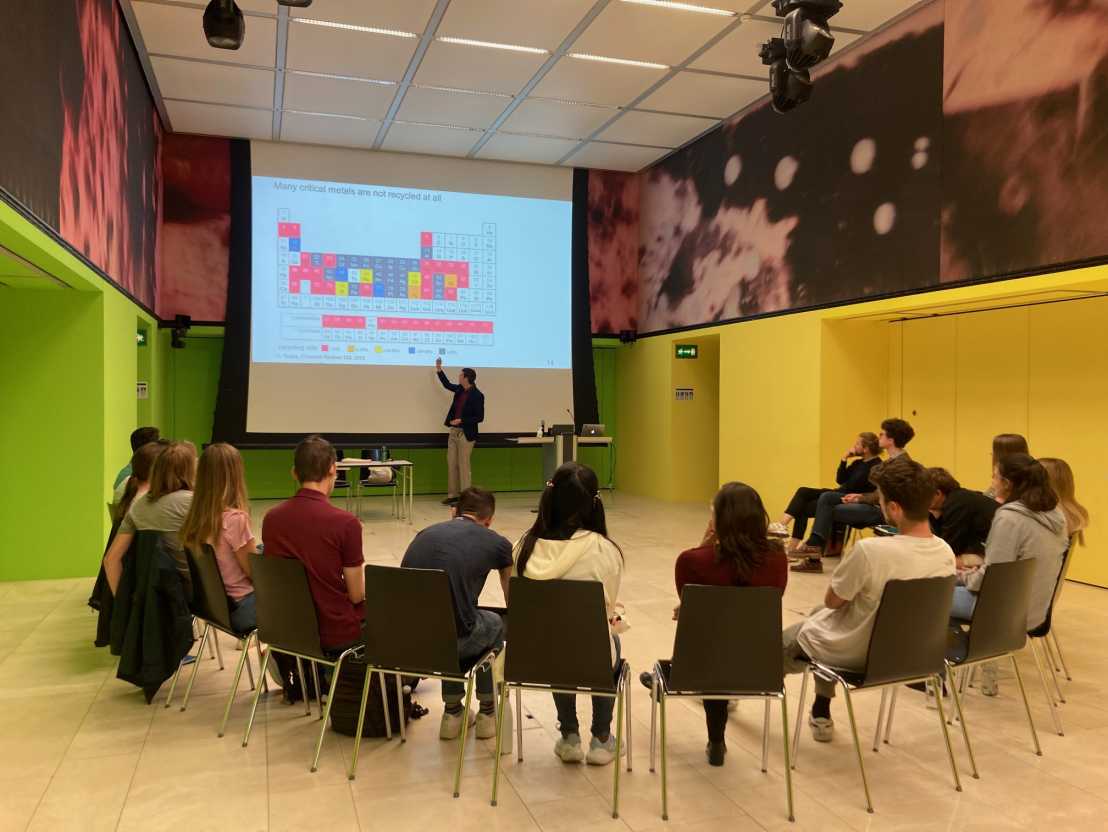MaP Minds & Munchies
In 2023/24, MaP Doctoral School offered monthly get-togethers over lunch. Doctoral students presented their research and discussed it with their peers. The format included lunch.
Schedule
11.00 Lunch
11.30 Klara Berg (MaP): Introducing the MaP Doctoral School
11.45 Caroline Brommesson (Agora Materia): Introducing Agora Materia
12.00 Misagh Ghezellou, Linköping University
4H-SiC is a wide bandgap semiconductor with exceptional properties ideal for high-power, high-temperature, and high-frequency electronics. Its potential extends to quantum technologies, where its defects can serve as quantum bits. This talk explores various CVD epitaxial growth approaches for 4H-SiC, addressing the challenges in achieving the material quality necessary for both power electronics and quantum device applications.
12.30 Aishwarya Vishwakarma (Magnetism and Interface Physics, D-MATL): Probing Magnetism of Spins on Surfaces Using EPR-STM
Molecule-based quantum devices rely heavily on the chemical engineering and fabrication of single molecular spins. Scanning tunneling microscope (STM) is a powerful method to characterize the electronic properties of conducting materials with atomic spatial resolution, but its energy resolution is limited (>1 meV at 4 K). On the other hand, electron paramagnetic resonance (EPR) is commonly utilized for spin detection, but it has limited spatial resolution. By combining EPR with STM, spins on surfaces can be imaged and coherently controlled with improved energy resolution (<1 μeV). In this talk, I will introduce the EPR-STM measurements of spins hosted in localized orbitals of single atoms and extended molecular orbitals of organic radicals.
Sophie Koch (Wood Materials Science, D-BAUG)
Compliant materials are gaining interest for soft robotics applications, but their sustainability and reusability are a concern, especially given their increasing utilization in daily life. We developed a bio based and biodegradable material consisting of delignified wood and a compliant and transparent gelatin glycerol matrix. This composite exhibits highly anisotropic mechanical behavior possessing high strength and stiffness in the fiber direction and high deformability perpendicular to it. With our proof-of-concept gripper, we show that this entirely biodegradable composite enables novel and sustainable approaches for soft robotics applications by capitalizing on wood's native structure.
Thilo Schmid (Durability of Engineering Materials, D-BAUG)
Moisture is crucial for all processes related to corrosion in concrete. In addition to the corrosion processes themselves, also the majority of measurement techniques rely on the conductivity of the concrete/mortar to establish electrolytical contact, i.e. they need a certain level of moisture. Thus, measuring dry mortar samples can quickly turn into a nightmare. In this talk, I will present some problems, bad solutions, slightly better solutions and ideas related to this topic.
Lorenza Garau Paganella (Experimental Continuum Mechanics, D-MAVT): 3D Hydrogel Models to Study Dermal Fibroblast Mechanobiology
Skin tissue is constantly subjected to mechanical stresses that elicit biological signaling cascades. These stresses are fundamental in tissue homeostasis and can be dysregulated during pathologies. Understanding how skin cells react to these stimulations can be fundamental to better understand disease progression and develop new therapies. However, to study these we need a correct set of platforms that allow us to avoid creating biased cell responses. We use 3D hydrogel materials to culture skin dermal fibroblasts and investigate how different physical and chemical stimuli affect cell responses. We integrate expertise in hydrogel design to mimic the in vivo environment of cells with advanced biomechanics characterization and modelling to provide insight on the physical mechanisms underlying skin function and pathology.
Valentin Gantenbein (Materials for Robotics, D-MAVT): Small-Scale Robotic Superstructures for Biomedical Applications
Miniature robots, or microrobots, are increasingly gaining attention for their potential applications in various fields, including medicine and environmental monitoring. Leveraging principles from robotics, materials science, and nanotechnology, researchers continue to push the boundaries of microrobot capabilities, enabling precise manipulation at sub-millimeter scales. As these technologies mature, microrobots hold promise for revolutionizing tasks such as targeted drug delivery, delicate assembly operations, and exploration of inaccessible or hazardous environments.
Kim Busenhart (Experimental Continuum Mechanics, D-MAVT): Exploring Material Properties of Collagen Hydrogels: An Experimental and Numerical Investigation of the Microstructure’s Influence on the Macroscopic Material Properties
Our work is focused on understanding the mechanical properties of soft biological tissues or tissue equivalent materials. In the presented experiments we examined and compared the mechanical properties of hydrogels with comparable collagen content but fabricated using distinct protocols. A series of experiments were conducted on these hydrogels, and a simple continuum-discrete model was employed in an attempt to numerically replicate the observed mechanical behavior and find the driving factors for the vastly different mechanical properties.
Robert Kindler (Wood Materials Science, D-BAUG / ALIVE): Microbial Exploration: Bacterial Motility in Wood Channels
While exploring the calcification of bulk wood with the help of microbes, I stumbled upon the visualization of bacteria within wood channels. This discovery has led me to take a detour from my initial projected shift my focus from the intricacies of bacterial motility. I am particularly interested in understanding how spatial confinement and the inherent structures of wood impact bacterial movement. In this presentation, I aim to share the preliminary data I have gathered and eagerly anticipate your insights and ideas.
Pius Theiler (Nanotechnology, D-MAVT): Why is Quantum Mechanics Wrong for Chiral Materials?
In my Kelvin probe force microscopy research, I discovered a chirality-induced spin-selective quantum capacitance on chiral materials published in P. Theiler et al. Nano Lett. 2023, 23, 17, 8280–8287. This observable violates time-reversal invariant quantum mechanics with far-reaching problems not discussed in the publication. I would like to discuss the idea of rewriting an axiom of quantum mechanics to make it compatible with chiral materials.
Julia Achatz (Wood Materials Science, D-BAUG): Towards an Explainable and Trustworthy Roundwood Sorting System based on Convolutional Neural Networks
The automation of roundwood sorting in sawmills is an upcoming topic to save money, improve the throughput and relieve employees. Convolutional Neural Networks (CNNs) emerged as a cost-efficient method for the effective implementation of this approach. However, the explainability of the black box models plays a crucial role for further development and deployment to industrial scale. This presentation discusses two different approaches to make quality and species decisions trustworthy and understandable.
Sophie Koch (Wood Materials Science, D-BAUG)
Compliant materials are gaining interest for soft robotics applications, but their sustainability and reusability are a concern, especially given their increasing utilization in daily life. We developed a bio based and biodegradable material consisting of delignified wood and a compliant and transparent gelatin glycerol matrix. This composite exhibits highly anisotropic mechanical behavior possessing high strength and stiffness in the fiber direction and high deformability perpendicular to it. With our proof-of-concept gripper, we show that this entirely biodegradable composite enables novel and sustainable approaches for soft robotics applications by capitalizing on wood's native structure.
Yifan Cui (Macromolecular Engineering, D-MAVT)
The International Energy Agency has documented a 93% increase in global energy consumption from 1971 to 2014. In 2018, the built environment alone accounted for 40% of worldwide greenhouse gas emissions. Growing awareness exists regarding the potential of construction materials to combat climate change by capturing and retaining atmospheric carbon. The idea of “building as a carbon sink” has become an attract strategy to actively transform atmospheric carbon dioxide into the lifecycle of the building materials.Leveraging the naturally occurring carbon sequestration pathways, we harness the photosynthetic abilities of microorganisms such as cyanobacteria for carbon uptake. The incorporation of microorganisms into supporting materials such as concrete, polymer and wood enabled the design of self-aware, self-healing and carbon negative building materials.
Alexander Firlus (D-MATL)
The production of metals accounts for 10% of the global energy consumption and 40% of all industrial greenhouse gas emissions. If it were a country, it would rank third in the world (after the US and China, and before India) in terms of CO2 emissions. Additionally, excavation and current refinement and metal production techniques cause a lot of environmental damage and toxic waste. Let’s explore what solutions and future research directions the field of sustainable metallurgy has to offer to overcome these challenges.
Arturo Winters (D-MATL): A comparison of fluctuations arising from two different microscopic models
The Maxwell model sets a benchmark for mesoscopic theories for complex fluids. Both Network and bead-spring models were validated by being able to reproduce the Maxwellian behavior. The former modeled it with the Temporary Network Model, while the latter with fluctuating dumbbells. As modern experimental techniques access higher degrees of precision with respect to time and length scales (e.g., modern (rheo-)confocal setups or scattering techniques), Brownian fluctuations play a determinant role. Thus, a mere deterministic and macroscopic equation does not comply with modern measurement capabilities. This motivates the comparison, both by analytical and numerical means, of the fluctuations in the Maxwellian stress predicted by the Temporary Network Model (TNM) and the Dumbell Model (DM), respectively.
MaP doctoral students received a registration link by email to sign up for the event.
If you'd like to participate but haven't received a link, please contact us at .
MaP Minds & Munchies was hosted by Christopher Dreimol (D-BAUG), MaP Student Representative 2023/24

Over 280 doctoral students belonging to more than 80 MaP groups spanning 10+ departments have signed up for MaP Doctoral School since the big bang event in 2021. Many of them don't know each other. MaP Doctoral School wants to change that. Because knowing what others are doing is the basis for cross-disciplinary collaborations.
Therefore, MaP Doctoral School invites its students to the new monthly MaP Minds & Munchies events.
What to expect
- two (casual) presentations by MaP doctoral students
- questions & discussions
- meeting fellow doctoral students
- lunch
Presentations: Volunteers wanted!
- Length: 10-20 minutes, questions included
- Content: your general research ideas, latest findings, research plan, or poster presentation for an upcoming conference
The MaP Minds & Munchies event is designed as a „scientific safe space“, in which doctoral students feel confident to share their latest ideas and results without inhibitions. This means that we do not provide a zoom link for this event.
If you'd like to give a presentation, please to us.
Please note that MaP Minds & Munchies is only for doctoral students affiliated with MaP Doctoral School. If and you want to join MaP Doctoral School*, please fill in the form here.
Co-organised by Christopher Dreimol (D-BAUG, MaP Student Representative) and MaP Doctoral School
* Precondition: Your professor needs to be a .
